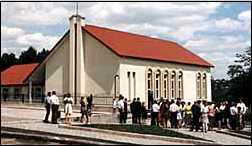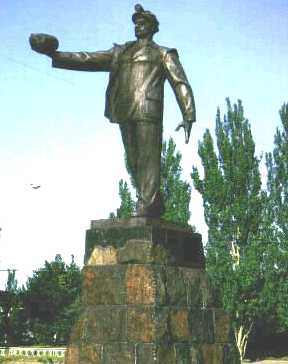Donetsk |
The Church in Donetsk.
Donetsk is the mission headquarters, and has more Church
members than any other city in the mission. The city was opened for missionary work in
1992. The first LDS chapel in Ukraine built by the Church is in Donetsk (right).
It was dedicated in June 1998. A second was completed in 1999. Donetsk has 6 branches in 2
districts, about 750 members total.
About the City.
History:
Donetsk was founded in 1869 and was originally known as Yuzovka after John Hughes.
Hughes was an English businessman who built a steel plant where Donetsk now stands. This
was the first steel plant in what was then Southern Russia. In 1924 Yuzovka was renamed
Stalino in honor of Josef Stalin of course. (Stal' is the Russian word for steel).
During the Second World War, German forces occupied Dontesk from 1941-1943. Between the
German invasion, the Red Army's "scorched earth" retreat and, later, the Soviet
liberation, the city was completely destroyed. Consequently there are no buildings older
than 50 years in Donetsk today. You won't see the ornate old buildings and onion-domed
churches you find in other cities. Also during the war, the population of Donetsk fell
from over 500,000 to just 175,000. Over 90,000 people were killed in concentration camps
located in and around the city. After the war the city was rebuilt rapidly, and in 1961
was renamed Donetsk.
Industry:
From the very beginning, heavy industry has dominated the Donetsk region. By 1874 the
Yuzovka steel plant was the largest steel producer in all of Russia. Today, the Donetsk
oblast puts out 26.7% of the industrial output of Ukraine. Donetsk has extensive and rich
natural resources. These resources include deposits of coal, rock-salt, and mercury which
are among the largest in Europe, as well as Ukraine's largest deposits of iron ore, rare
metals, metallurgical fluxes, fireproofing and glass-producing materials.
 Donetsk is a mining town at heart. From
monuments like the miner statue at left, to street names ("Mine builders
street") and hotels (the "Miner"), from holidays ("Miners' Day"),
to the stadium and soccer team (both "Miner"), reminders are everywhere that
coal mining is the lifeblood of the city. Over 30% of the labor force is employed in
mining and related supporting industries. Unfortunately, of all the coal basins in the
former USSR, the Donetsk basin was geologically the most difficult, and in the final years
of the Soviet Union it was allowed to deteriorate technologically. Today Donetsk is dotted
with massive mountains of tailings, strewn both throughout the countryside and in the city
landscapes. These are caled "terracones," and there are over 3000 of them in the
Donetsk region. They can be over 100 meters tall, making them a dominant feature of the
landscape. Donetsk, stands precariously on a maze of mining tunnels, and trains are
required to slow down as they travel through the city so as not to cause underground
cave-ins. Mine accidents are very common. Over 300 miners a year die in explosions and
cave-ins in Ukraine, most in the Donetsk region.
Donetsk is a mining town at heart. From
monuments like the miner statue at left, to street names ("Mine builders
street") and hotels (the "Miner"), from holidays ("Miners' Day"),
to the stadium and soccer team (both "Miner"), reminders are everywhere that
coal mining is the lifeblood of the city. Over 30% of the labor force is employed in
mining and related supporting industries. Unfortunately, of all the coal basins in the
former USSR, the Donetsk basin was geologically the most difficult, and in the final years
of the Soviet Union it was allowed to deteriorate technologically. Today Donetsk is dotted
with massive mountains of tailings, strewn both throughout the countryside and in the city
landscapes. These are caled "terracones," and there are over 3000 of them in the
Donetsk region. They can be over 100 meters tall, making them a dominant feature of the
landscape. Donetsk, stands precariously on a maze of mining tunnels, and trains are
required to slow down as they travel through the city so as not to cause underground
cave-ins. Mine accidents are very common. Over 300 miners a year die in explosions and
cave-ins in Ukraine, most in the Donetsk region.
While the region's 119 active mines still produce half of Ukraine's coal, about 50 mln.
tons annually, free market principles do not yet guide the progress of this industry, as
it continues to function under the control of the Ukrainian Coal Ministry, with state
subsidies, mind-boggling bureaucracy, and rampant corruption. Mine associations prop up
inefficient mining enterprises, simultaneously holding back the growth and potential of
some of the stronger mines. Soviet-era housing complexes, day-care centres, and other
communal properties represent another drain on the scarce resources of these enterprises.
Miners strikes are common
Current Problems:
There is a large ethnic Russian minority in all of Eastern Ukraine. Donetsk is 45% Russian
vs. 22% for country as a whole. This results in increased tension between Russians and
Ukrainians. Many Russians resent having Ukrainian language and culture thrust on them by
the Kiev government. Because of these tensions, the Kiev government fears succession. As a
result, the national government has been forced to make some concessions. For example
Donetsk and Lugansk are the only two oblasts (regions) where Russian and Ukrainian are
both official languages. The Donetsk region is alo the last area of the country to receive
consumer goods. This only adds to the perception among the Russian minority that the
national government is neglecting them.
Donetsk suffers from the same environmental problems as the rest of the former Soviet
Union. Air pollution is an ongoing problem. 70% of the hydrocarbons etc. polluting the air
in Ukraine are produced in the Donetsk region. In 1980 lung cancer rates (excluding
miners) in Donetsk were 300% higher than in the rest of the Soviet Union.